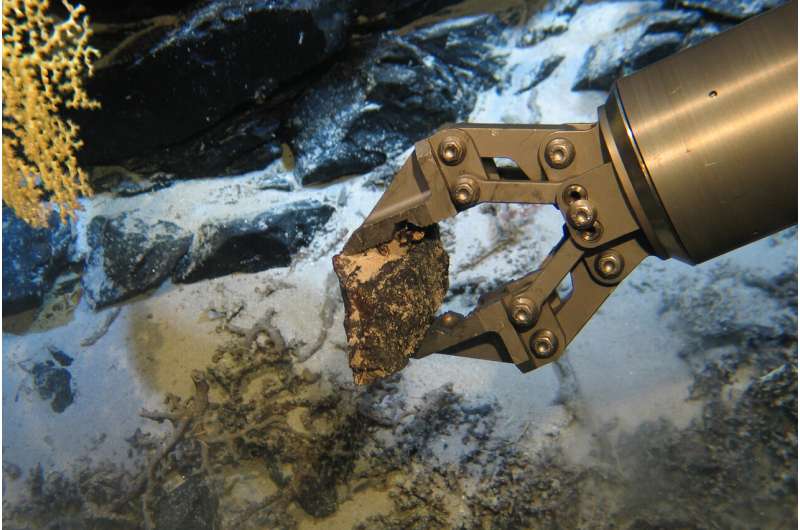This article has been reviewed according to Science X's editorial process and policies. Editors have highlighted the following attributes while ensuring the content's credibility:
fact-checked
peer-reviewed publication
trusted source
proofread
Hydrothermal mercury: The natural story of a contaminant

An international team of researchers including scientists from the GEOMAR Helmholtz Center for Ocean Research Kiel has produced the first global estimate of mercury emissions from hydrothermal sources at mid-ocean ridges based on measurements.
The researchers were able to show that most of the mercury in the ocean comes from human activities—and can therefore be reduced. Their findings have been published in the journal Nature Geoscience.
Ten years ago, the United Nations agreed to minimize mercury pollution in the environment to protect human health: the Minamata Convention was adopted in Geneva in 2013. Signatory countries committed to controlling and minimizing the release of mercury. One of the main sources of human mercury intake is the consumption of contaminated fish, which accumulate mercury dissolved in seawater.
It is estimated that anthropogenic activities have increased the global mercury reservoir in the ocean by 21%. However, this figure is difficult to verify because it was not known exactly how much natural mercury was present in the ocean before anthropogenic emissions began. It is therefore equally difficult to say how much these have influenced mercury levels in fish.
To fill this knowledge gap, an international team of researchers led by the French National Center for Scientific Research (Center national de la recherche scientifique, CNRS) has now produced the first global estimate of mercury emissions from hydrothermal sources at mid-ocean ridges, volcanically active areas in the world's oceans, based on measurements.
Dr. Sven Petersen, a geoscientist in the "Marine Mineral Resources" working group at the GEOMAR Helmholtz Center for Ocean Research in Kiel, where metals in the ocean are an important research focus, is a co-author of the study. "Hydrothermal vents are the most important direct source of natural mercury in the ocean," he explains, "but until now, the data on how much mercury they contribute has varied between 20 and 2,000 tons per year." This is mainly due to the fact that previous studies have only measured the hot solutions escaping from the sources.
For the current study, published in the journal Nature Geoscience, the scientists analyzed not only the escaping fluids but also clouds of suspended matter known as plumes, seawater and rocks. The samples were collected during the GEOTRACES and ODP (Ocean Drilling Program, predecessor of the Integrated Ocean Drilling Program, IODP) expeditions. GEOTRACES expeditions focus on the study of trace metals and their distribution in the oceans, while ODP expeditions drill rock samples from the seafloor.
"Our combined observations suggest that most of the mercury accumulated in the hot solutions is diluted in seawater," says the study's lead author, Dr. Lars-Eric Heimbürger-Boavida, a CNRS scientist at the Mediterranean Institute of Oceanography (MIO). Only a small fraction is precipitated locally and remains on the seafloor. Overall, the results show that the global hydrothermal mercury flux from mid-ocean ridges is small compared to anthropogenic mercury emissions.
First author Natalia Torres-Rodriguez, Ph.D. student at the MIO, says, "This ranges from 1.5 to 65 tons per year." This suggests that the majority of mercury in the ocean is of anthropogenic origin. With this result, the researchers hope that the strict implementation of emission reductions under the Minamata Convention will reduce mercury levels in fish and human exposure.
About mercury and the Minamata Convention
Mercury (Hg) is a heavy metal that occurs in metallic, oxidized or organically bound forms. Apart from acute poisoning from handling elemental mercury, methylmercury poses the greatest threat to humans and the environment. The compound accumulates in the food chain and can lead to poisoning and irreversible brain damage, particularly in fetuses and young children, if larger species of fish are consumed in above-average quantities.
Mercury is naturally released into the atmosphere by volcanic eruptions, geysers or the burning of biomass (e.g., forest or grassland fires). Additional releases occur as a result of human activities such as the mining of mercury ores and other mercury-containing rocks such as limestone or coal. Mercury emissions are global, meaning that non-industrialized areas are also polluted.
According to a 2018 publication, about 3,100 tons of mercury are released annually as a result of human activities.
Against this backdrop, 128 countries, including Germany, adopted the United Nations Environment Program's (UNEP) Minamata Convention in 2013 to reduce mercury emissions worldwide. It is named after the bay in Japan where industrial wastewater containing mercury poisoned thousands of people in the mid-20th century, leading to serious health problems known as "Minamata disease."
More information: Natalia Torres-Rodriguez et al, Mercury fluxes from hydrothermal venting at mid-ocean ridges constrained by measurements, Nature Geoscience (2023). DOI: 10.1038/s41561-023-01341-w
Journal information: Nature Geoscience
Provided by Helmholtz Association of German Research Centres





















